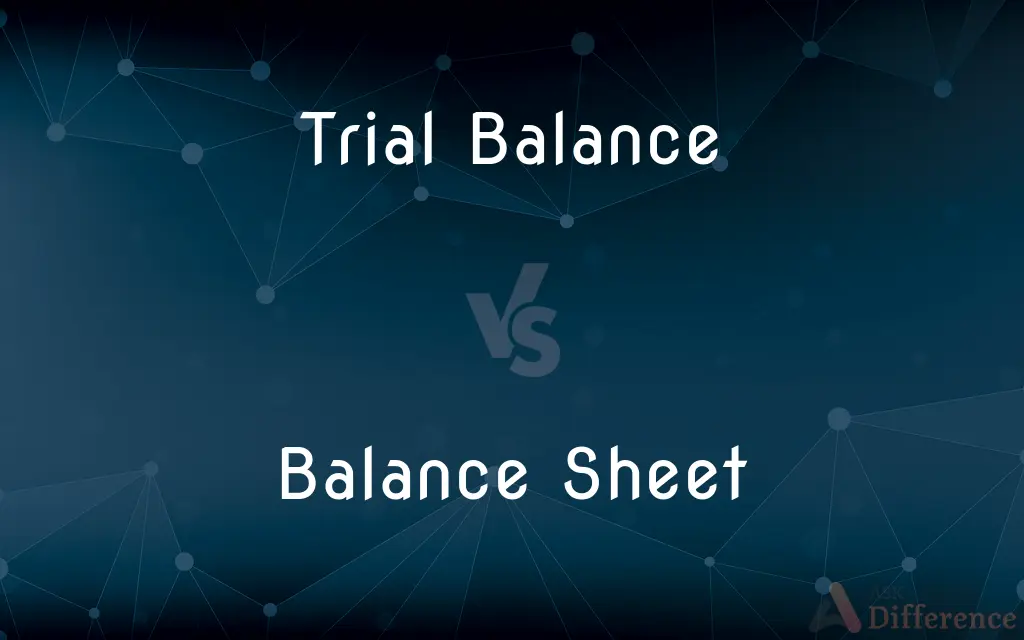Trial Balance vs. Balance Sheet — What's the Difference?
By Tayyaba Rehman — Published on October 30, 2023
Trial Balance is an internal report listing all account balances to prove ledger balances' mathematical accuracy; Balance Sheet is a financial statement showcasing a company's assets, liabilities, and equity at a specific point in time.

Difference Between Trial Balance and Balance Sheet
Table of Contents
ADVERTISEMENT
Key Differences
Trial Balance serves as a preliminary, internal accounting tool, designed to verify the arithmetical accuracy of the general ledger by listing all account balances during a specified time frame. Its primary purpose is to ensure that for every debit entry recorded, there is an equal and opposite credit entry, without providing insights into the company’s financial position or performance. In contrast, a Balance Sheet is a fundamental financial statement, intended for external users like investors, creditors, and analysts, providing a snapshot of a company's financial condition at a specific point in time by outlining its assets, liabilities, and shareholders' equity.
The Trial Balance’s role is essential for internal stakeholders like accountants and auditors who utilize it as a first step in the preparation of financial statements. It's primarily a tool to identify any discrepancies in the ledger before the final financial statements are prepared. Balance Sheet, on the other hand, is crucial for both internal and external stakeholders, offering detailed insights into the company’s financial standing, allowing for analyses of liquidity, solvency, and capital structure, which are critical for decision-making processes.
While the Trial Balance is produced more frequently, often monthly, and is used internally to identify errors in the accounting system, the Balance Sheet is typically generated at the end of the accounting period, such as quarterly or annually, and is a formal disclosure of the company’s financial status. The Trial Balance, with its limited scope, does not disclose the company’s financial health, whereas the Balance Sheet provides an exhaustive view of the financial position and is a key component of the financial statements shared publicly.
A Trial Balance merely presents a list of all ledger accounts in a tabular form, without classifying them into major categories like assets or liabilities. It is simply a working paper for accountants, ensuring that the total debits equal total credits. A Balance Sheet, in contrast, meticulously categorizes each account under assets, liabilities, or equity and is a finalized, structured document that conveys rich financial information to users, assisting them in assessing financial stability, performance, and growth prospects.
It is imperative to note that the Trial Balance is an intermediary step in the accounting cycle, instrumental in the accurate preparation of financial statements, especially the Balance Sheet. While the Trial Balance assists in ensuring mathematical correctness, the Balance Sheet acts as a mirror reflecting the financial robustness and viability of a company, helping stakeholders make informed economic decisions.
ADVERTISEMENT
Comparison Chart
Purpose
To verify the arithmetic accuracy of the ledger.
To showcase financial condition at a specific point.
Users
Internal: accountants, auditors.
Both internal and external: investors, creditors.
Disclosure
Not disclosed to external parties.
Disclosed to the public as part of financial statements.
Frequency
Produced more frequently, often monthly.
Produced at the end of an accounting period.
Classification & Structuring
Lists all accounts without specific classification.
Classifies into assets, liabilities, and equity.
Compare with Definitions
Trial Balance
Trial Balance is an internal accounting report listing all account balances.
The accountant prepared the Trial Balance to check the arithmetic accuracy of the ledger.
Balance Sheet
Balance Sheet is structured, categorizing accounts meticulously under assets, liabilities, or equity.
The Balance Sheet is well-organized, presenting a clear view of financial positions in various categories.
Trial Balance
Trial Balance is prepared to verify that total debits equal total credits.
A mismatch in the Trial Balance signaled discrepancies in the ledger entries.
Balance Sheet
Balance Sheet is prepared at the end of an accounting period and is part of the financial statements.
The annual report included the Balance Sheet, prepared as of the last day of the year.
Trial Balance
Trial Balance is used to identify errors in the accounting system.
Any errors in the accounting entries were highlighted during the preparation of the Trial Balance.
Balance Sheet
Balance Sheet is used to analyze liquidity, solvency, and financial performance.
The Balance Sheet is instrumental in conducting various financial analyses to gauge the company’s stability.
Trial Balance
Trial Balance is an intermediary step in the preparation of financial statements.
The Trial Balance is crucial for ensuring accuracy before preparing the Balance Sheet.
Balance Sheet
Balance Sheet provides insights into a company’s financial health and is used by various stakeholders.
Investors closely scrutinize the Balance Sheet to assess the company's financial viability.
Trial Balance
Trial Balance does not classify accounts into assets, liabilities, or equity.
The Trial Balance merely lists all accounts without distinguishing between assets and liabilities.
Balance Sheet
Balance Sheet is a financial statement showing a company’s assets, liabilities, and equity at a specific date.
The Balance Sheet revealed the company’s financial standing on the last day of the fiscal year.
Common Curiosities
What is the purpose of a Trial Balance?
It is prepared to verify the arithmetic accuracy of the ledger by ensuring total debits equal total credits.
What information does the Balance Sheet convey?
It provides a snapshot of a company's assets, liabilities, and equity at a specific point in time.
Share Your Discovery

Previous Comparison
Ionic Compounds vs. Molecular Compounds
Next Comparison
Western Europe vs. Eastern EuropeAuthor Spotlight
Written by
Tayyaba RehmanTayyaba Rehman is a distinguished writer, currently serving as a primary contributor to askdifference.com. As a researcher in semantics and etymology, Tayyaba's passion for the complexity of languages and their distinctions has found a perfect home on the platform. Tayyaba delves into the intricacies of language, distinguishing between commonly confused words and phrases, thereby providing clarity for readers worldwide.












































